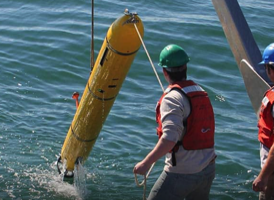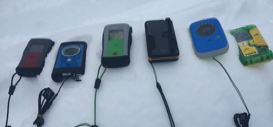Introduction and Status
Although there is no definitive count, an AUV going missing is not a rare occurrence. Examples from Arctic latitudes include:
• A WHOI Puma class AUV missing under sea ice, found after obtaining a position within 10s of metres using helicopter-dunked acoustic positioning, and then to a few metres using an avalanche beacon.
• Being unable to make connection with an acoustic transponder, the Theseus AUV parked itself under sea ice just 1km from First Base on the return leg of the Spinnaker expedition. The AUV team went to the site, lowered the transponder to a greater depth to establish communication, reset vehicle parameters, and sent it on its way to the mission end-point.
• A University of British Columbia Gavia AUV was missing under lake ice in Finland for some 123 hours, despite being on a tether that had become entangled. First, a search on foot with a receiver for the vehicle's avalanche beacon. However, thin and rotting ice made this hazardous, and the method was abandoned. A shore-based hydrophone showed no signals, with the hydrophone in a boat and paddled around the expected area, there were still no signals. Finally, during on-going visual surveillance while making other measurements the line was spotted; 100s of metres recovered, and the Gavia.
These three examples used just two of the methods currently available to help find a missing AUV, others include an independent satellite GPS beacon, useful only if the vehicle is on the surface, and a simple flashing light, which as well as being useful on the surface can be seen under thin, translucent ice. Further details on these methods and their implementation can be found below.
Modules that are only effective when the AUV is on the surface
• One or more completely independent satellite GPS beacon(s). Several models of self contained, self-powered beacons are available that combine a GPS receiver with an Iridium (or other satellite system) one-way or two-way communications link. Some models can be externally powered and fall back to internal power if there is a fault with the main power. These can be used as a normal GPS receiver and Iridium communications link. However, a risk assessment may suggest that, in addition to the primary GPS and Iridium systems, a truly self contained unit with its own antenna should be included.
Vendors of these devices may also offer a matching Deck Unit to provide Iridium communications. Such a device would be useful at an ice camp or on a ship at latitudes above 82˚ where access to geostationary satellite communications may not be possible.
Modules that are effective when the AUV is on the surface or when sub-surface
• Flashing light. Even if the vehicle is fitted with a satellite GPS beacon, and on the surface, if it is dark, or visibility is poor, then a flashing light will help in finding the AUV. If the vehicle is just sub-surface, for instance under a layer of nilas ice, or does not have the buoyancy to rise to the very surface if there is a lens of very low salinity melt water, a flashing light could still be seen while a satellite GPS beacon may not function if its antenna is sub-surface.
• Acoustic beacon, or transponder. Acoustic beacons or transponders are a common relocation aid on AUVs. Depending on the transmission frequency and the acoustic propagation environment ranges of tens of kilometers can be achieved. If the ship or ice camp has an Ultra-Short Baseline (USBL) acoustic navigation system the 3D position (east, north, depth) of the beacon or transponder can be obtained under certain conditions. If an USBL is not available, or proves not to be suitable, then it may be possible to triangulate the position of the beacon from time travel measurements at two or more locations (for a transponder) or, for a beacon from a ship, using the technique of running fixes.
Whatever the method, there are two main constraints. First, the beacon must be within range, which will undoubtedly depend on the acoustic propagation conditions. Alexander and others have studied acoustic propagation under sea ice with the specific aim of aiding monitoring, emergency response and navigation of under-ice AUVs. Second, the geometry must be suitable, that is, reception is more likely for an AUV that is not up against the underside of sea ice. Some AUVs, such as the UK Autosub, have included a self-contained acoustic beacon that is automatically lowered on the end of a line if power is lost or a fault detected. The objective being to place the beacon beneath ice keels or lenses of fresh water. As an example, the Autosub 4.5kHz beacon, on the end of a 15m line, was detectable at a range of 26km.
Confidence in the emergency acoustic beacon and propagation conditions can be achieved if the beacon is always operating, but at a reduced ping rate, e.g. once every ten minutes, in normal circumstances with an emergency signalled by a reduced ping interval.
• Radio frequency avalanche beacon. Electromagnetic propagation within a conducting medium is subject to a frequency-dependent attenuation. At the L-band frequencies used by GPS and Iridium satellites even millimetres of seawater is sufficient to block signals. However, at frequencies below the standard AM-band useful ranges can be achieved. Inexpensive, readily available personal avalanche beacons operate at 475kHz, a frequency subject to about 24dB per metre attenuation in seawater. Designed to enable a walker with a surface receiver to find the beacon under snow, these beacons have been used on AUVs operating in ice-covered Arctic lakes as well as in the Arctic Ocean and surrounding seas. To be effective, the AUV needs to have come up to under the ice. The beacon should be in the upper part of the AUV, unless it is small, such as REMUS, Gavia or a glider, the ice being essentially transparent to radio waves. A common detection tange is of the order of 70m, with some units, e.g. from Barryvox, capable of 100m in extended search mode.
Some comments on search methods
As with any of the technologies covered in this section thorough understanding and practice is needed to become proficient in their use. Pre-planned search patterns should have been rehearsed and available, if possible under the actual conditions to be faced. Importantly, the prior understanding needs to include the likely directional pattern of the transmitter within the vehicle.
A suitable initial signal search strategy is to follow a lawnmower pattern, with the separation between legs no more than the expected detection range for the method used. On detecting a signal, the coarse search method will differ between methods.
For example, with an acoustic transponder on the vehicle and a USBL receiver range and bearing will be obtained. It may be wise to check the first result, if possible, from a position that gives a line at right angles to the first, to give an idea of the size of what will be the fine search area. This triangulation approach has to be used if range information only is available from the acoustic transponder. A running fix approach can also be used, where a searcher follows a straight-line course that brings the range to a minimum, continues on that course for a short while, then alters course by 90˚ (to port or starboard), and brings the range to a minimum (if the correct turn was taken), otherwise, turn through 180˚. Where the lines drawn at right angles to the course at the positions of minimum range cross becomes the fine search area.
Avalanche beacons often have dipole- or bar-magnet-like fields, and the hand-held receiver display may guide the searcher on a curved path along a line of equal signal strength rather than via a path crossing successively stronger signal contours. Mountain rescue operations have taken place with avalanche beacon receivers on small, multi-rotor, unmanned aerial vehicles (UAVs), and this could be an effective technology for use in Polar Regions where the ice may be too thin for safe searching by people.
Example of a self-contained Iridium satellite beacon that relays GPS position. This Tiger Shark unit in a titanium housing is rated at 3000 or 6000m. Right: A wide range of pressure-resistant GPS, WiFi, Iridium and combined GPS-Iridium antennas. A matching Deck Unit is available to provide Iridium communications to an ice camp or a ship. Images from Trident Sensors.
Finding a Missing AUV



Bluefin AUV with a Sonardyne AvTrack6 3-in1 instrument: USBL transponder, Long Baseline transceiver and data modem. This instrument, specifically designed to be part of an AUV tracking and navigation system, also has an emergency relocation mode. Depth rating options to 7000m and with options to suit different vehicles. Image courtesy Sonardyne.

In January 2004 Autosub2 became missing, having to be found using its acoustic transponder and recovered by ROV. An unobserved impact to a dive plane at the surface led to a steep dive with its bottom avoidance sonar no longer pointing toward the bottom. Nevertheless, the vehicle made progress, its nose in the sediment, until so much sediment collected that it stopped. The weight was more than enough to keep the vehicle on the bottom despite dropping its emergency weight.

A small selection of the personal avalanche beacons that are available of the type that have been repackaged for use with AUVs in high latitudes. From an Off-Piste review article.

An avalanche beacon receiver antenna deployed beneath a Pros3 Venture UAV by Silvagni et al. The UAV and its control system undertakes autonomous search patterns to home in on the beacon signal.
